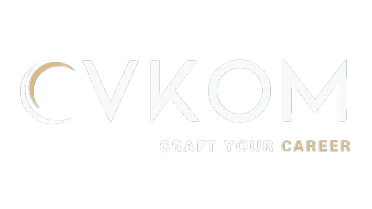Land Your New Job: Explain Your Career Shift
- Highlight Transferable Skills: Focus on skills valuable in your new career.
- Explain Your Motivation: Briefly and positively explain your reason for the shift.
- Show Your Commitment: Demonstrate your dedication to your new career path.
CVKOM helps you craft a compelling cover letter that showcases your value.
How to
Explain Career Shifts in a Cover Letter
Explaining a career shift in a cover
letter can feel daunting, but it’s an opportunity to showcase your
adaptability, transferable skills, and passion for your new career path. A
well-crafted cover letter can turn a potential concern into a strength, reassuring
employers that you are prepared for the role despite your unconventional
background. At CVKOM, we help job seekers craft cover letters that
effectively communicate their career transitions. Here's how to do it.
1.
Start with a Strong Introduction
Your introduction should immediately address the career shift in a positive and confident tone. Show enthusiasm for
the new role and establish credibility by emphasizing your transferable skills.
Example:
"I am excited to apply for the Project Manager position at [Company
Name]. With a background in education and over five years of experience leading
teams, I have honed organizational and leadership skills that I am eager to
bring to the dynamic world of project management."
2.
Emphasize Transferable Skills
Identify skills from your previous
roles that are directly applicable to the new career. Highlight these skills to
show you have a strong foundation for success in the new role.
Common Transferable Skills:
- Leadership and team management
- Communication and interpersonal skills
- Problem-solving and adaptability
- Time management and organizational skills
- Analytical thinking
Example:
"As a teacher, I mastered the art of managing diverse teams, meeting
tight deadlines, and designing strategic lesson plans—all skills that align
closely with the responsibilities of a project manager."
3.
Explain the Reason for the Career Change
Provide a brief explanation of why you are making the career change. Focus on the positives, such as discovering a
new passion, seeking professional growth, or wanting to align your career with
your long-term goals.
Tips:
- Keep this section concise and positive.
- Avoid emphasizing dissatisfaction with your previous
career.
Example:
"After several years in education, I realized my passion lies in
organizing and optimizing processes to achieve measurable outcomes. This
discovery led me to pursue a certification in project management and shift my
career toward a field where I can apply my skills on a broader scale."
4.
Highlight Relevant Achievements
Use examples from your previous
career that demonstrate your ability to succeed in the new role. Focus on
accomplishments that showcase skills valuable in the new industry.
Example:
"In my previous role, I led a cross-departmental initiative to
integrate digital tools into the curriculum, which improved student engagement
by 30%. This experience taught me how to manage resources, collaborate with
stakeholders, and deliver impactful results."
5.
Demonstrate Your Commitment to the New Career
Example:
"To build my expertise in project management, I recently completed the
PMP certification and volunteered to lead a team for a local nonprofit project.
These experiences have equipped me with the skills to excel in this role."
6.
Align Your Goals with the Company’s Mission
Demonstrate how your career shift
aligns with the company’s goals and values. This reassures employers that your
decision is thoughtful and strategic.
Example:
"I am inspired by [Company Name]’s commitment to innovation and
teamwork. I am eager to bring my passion for organization and collaboration to
your team, contributing to projects that drive meaningful impact."
7.
Conclude with Confidence
Example:
"Thank you for considering my application. I am excited about the
opportunity to bring my unique background and skills to [Company Name] and look
forward to the chance to discuss how I can contribute to your team."
Example
of a Career Shift Cover Letter
Dear [Hiring Manager's Name],
I am thrilled to apply for the
Marketing Specialist position at [Company Name]. With a background in
journalism and over six years of experience crafting compelling stories, I am
eager to bring my communication skills and creative vision to your dynamic
marketing team.
In my previous role as a journalist
at [Previous Company], I conducted in-depth research, created engaging content,
and managed tight deadlines—all while maintaining a focus on audience
engagement. These experiences have equipped me with the ability to analyze
market trends, develop impactful messaging, and connect with diverse
audiences—skills that align seamlessly with the responsibilities of a marketing
specialist.
My decision to transition into
marketing was driven by a growing interest in using storytelling to drive brand
growth and consumer loyalty. To prepare for this shift, I completed a Digital
Marketing certification through [Institution Name], where I gained hands-on
experience in SEO, social media strategy, and content marketing.
I am inspired by [Company Name]’s
innovative approach to marketing and your commitment to delivering exceptional
customer experiences. I am confident that my skills and fresh perspective can
contribute to your team’s success.
Thank you for considering my
application. I look forward to the opportunity to discuss how my background and
passion for marketing can add value to [Company Name].
Sincerely,
[Your Name]
Common
Mistakes to Avoid
- Overexplaining the Career Shift: Keep your explanation brief and focus on the
positives.
- Undermining Your Experience: Frame your previous roles as assets, not limitations.
- Failing to Tailor the Letter: Customize your cover letter for the specific role and
company.
- Ignoring Transferable Skills: Always highlight how your past experiences are
relevant.
How
CVKOM Helps You Craft a Career Shift Cover Letter
At CVKOM, we provide tools
and resources to help you create a cover letter that effectively communicates
your career change:
- Customizable Templates: Designed to showcase transferable skills and align
with your new career goals.
- AI-Powered Suggestions: Get personalized recommendations for addressing career
shifts confidently.
- Professional Guidance: Learn how to frame your career change positively and
persuasively.
Conclusion
Writing a cover letter for a career
shift is about positioning your unique background as an asset and showing your
commitment to the new field. By focusing on transferable skills, highlighting
relevant achievements, and aligning with the company’s goals, you can make a
compelling case for why you’re the right candidate. At CVKOM, we’re here
to help you create cover letters that turn career transitions into
opportunities. Start building your career shift cover letter today!






